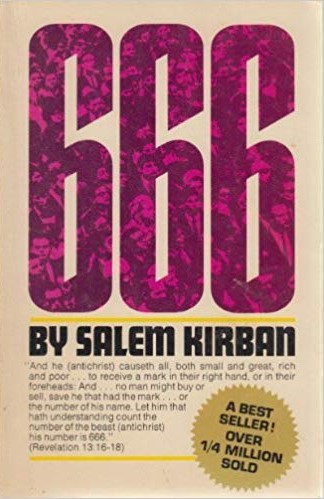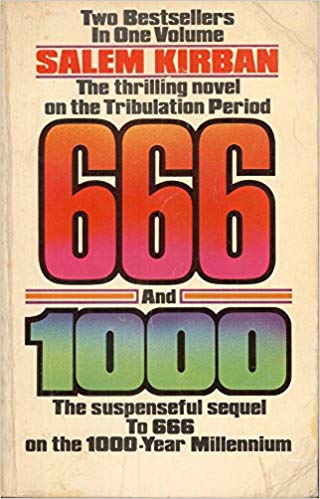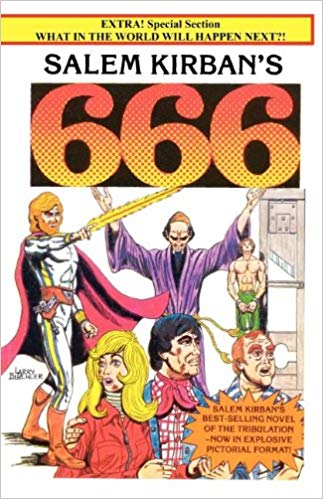Salem Kirban (1925-2010) was a Pennsylvania based biblical scholar and self-proclaimed “author of future events.” A rare example of a born-again Arab, Kirban came on like a combination of Billy Graham and Alex Jones, a (seemingly) dedicated Bible thumper and conspiracy theorist who inveigled against atheism and the illuminati with equal fervor.
 During his lifetime Kirban self-published over thirty books, including THE SALEM KIRBAN REFERENCE BIBLE, SATAN’S MARK EXPOSED, HOW TO BE SURE OF CROWNS IN HEAVEN and 1970’s 666, a novel that made quite a splash on the evangelical fiction circuit. An example of “Prophecy Fiction” describing the events of the rapture and resulting tribulation period, 666 was not (as has been mistakenly inferred) the “first” book of its kind, but it was a trailblazer, effectively setting the tone for the Mark IV apocalypse film series and the popular LEFT BEHIND novels of Tim LaHaye and Jerry B. Jenkins. In its first edition 666 went through a reported ten printings in three years, selling half a million copies, and was followed by a 1973 sequel and a graphic novel adaptation in 1980.
During his lifetime Kirban self-published over thirty books, including THE SALEM KIRBAN REFERENCE BIBLE, SATAN’S MARK EXPOSED, HOW TO BE SURE OF CROWNS IN HEAVEN and 1970’s 666, a novel that made quite a splash on the evangelical fiction circuit. An example of “Prophecy Fiction” describing the events of the rapture and resulting tribulation period, 666 was not (as has been mistakenly inferred) the “first” book of its kind, but it was a trailblazer, effectively setting the tone for the Mark IV apocalypse film series and the popular LEFT BEHIND novels of Tim LaHaye and Jerry B. Jenkins. In its first edition 666 went through a reported ten printings in three years, selling half a million copies, and was followed by a 1973 sequel and a graphic novel adaptation in 1980.
It’s a rare novel that delivers exactly what you’d expect, but 666 does just that, being crude, ham-fisted and amateurish. A good science fiction writer can conjure a thrilling novel from biblical prophecy (as evinced by Garry Kilworth’s ARCHANGEL and John Shirley’s THE OTHER END), but Salem Kirban’s writing skills, I’d say, were negligible at best.
666 is at least rendered in easy-to-read prose and heavily illustrated. Those illustrations are the book’s most unique elements, comprised largely of actual photos recontextualized to fit Kirban’s agenda (a practice adopted by the 1998 evangelical film APOCALYPSE, which utilized TV news footage to enhance its narrative). Among the photographic sights on display are a train crash, garbage-lined city streets, chanting crowds and piles of corpses, which often inform rather than amplify the events of the narrative; an example of such occurs in a photo depicting a crowd of people holding up Chairman Mao signs, which Kirban utilizes to illustrate a passage describing China’s new leader, who apparently bears a “striking resemblance” to Chairman Mao.
Of a similar hue is the book’s the other unique attribute: the use of bold faced biblical quotations that appear alongside the text. These quotes, meant to show Kirban’s scriptural integrity, are helpful in explaining why the narrative is such an unwieldy hodgepodge, with Kirban constantly attempting to come up with things—such as a description of Russian horsemen invading Israel, to go with the Revelations passage about a “horse that was red: and power was given to him that sat thereon to take peace from the earth”—that might adhere to the scripture he includes.
It’s all related from the point of view of George Omega, a TV reporter who, in the “future” year 2000, finds himself aboard an airplane in which quite a few of his fellow passengers, together with the plane’s pilot and Omega’s own bible-thumper wife, all vanish into thin air–raptured, that is, as it seems the seven year tribulation period predicted in the Bible has commenced. From there Omega’s role is largely reactive as Earth is plagued by rioting, starvation and cannibalism, with Brother Bartholomew, a charismatic individual who is in fact the Anti-Christ, uniting the planet.
Bartholomew’s influence only increases after he’s killed by a protester but then brought back to life. He consolidates his power by proclaiming himself the new messiah and forcing the world’s citizenry to be imprinted with the mark of the beast–666–on their forehead. There follows a riot of apocalyptic mayhem: meteor strikes, a “plague” of flying men in jet-packs (in place of the locusts described in the Bible), water turning to blood and mass warfare, culminating in a battle at the site of Megiddo in Israel, a.k.a. the Valley of Armageddon, between the armies of Brother Bartholomew and those of God. I think you can guess who wins.
Unfortunately it’s in those climactic passages that things really go awry storytelling-wise, with Kirban losing control of his narrative completely. Not that the rest of the book is in any way exemplary, diminished as it is by overly perfunctory, immersion free descriptions—as in one detailing a trip to the moon to find a rejuvenation formula, which is remarkably blasé and matter-of-fact—and a simplistic view of salvation, which is presented as, essentially, a marathon in which stamina trumps faith, as is made clear in a poetic passage proclaiming that “It’s not the first mile that’s so important, it’s the last mile when day is done. Then you’ll see Jesus in all his splendor, and he’ll have for you the crown you’ve won!”
The whole mess is wrapped up with a lengthy nonfiction afterward entitled “What Will You Do With Jesus?” Here Kirban does his best to scare his readers into accepting Jesus Christ, promising that “All of your riches here on earth—all of your financial security—all of your material wealth, your houses, your land, will crumble into nothingness in a few years,” and that “Understanding this, why not bow your head right now and give this simple prayer of faith to the Lord.”
Onto the “suspenseful sequel” to 666: 1973’s 1000, which is a lackluster effort by any standard. Written in the same format  as its predecessor, with copious photographic illustrations and bold-faced Biblical quotations running parallel with the text, it purports to dramatize the 1000 year millennial period that according to the Bible is set to follow the tribulation.
as its predecessor, with copious photographic illustrations and bold-faced Biblical quotations running parallel with the text, it purports to dramatize the 1000 year millennial period that according to the Bible is set to follow the tribulation.
George Omega is back in the passive observer role. Here everything on earth is peachy, with those who were raptured at the beginning of 666, including Omega’s wife Helen, brought back bearing god-like powers. In this idyllic period there is “no more art for art’s sake or scientific energies wasted on improving liquor quantities,” with Satan chained up in a bottomless pit. It seems another one world government has been instituted, this one much more copacetic than that of Brother Bartholomew, as it’s under the control of the actual God rather than a false one. Yet there’s discontent among certain folk, who bristle at this theocratic consolidation of power.
An interesting set-up, admittedly, with concepts that seem worthy of a more thorough exploration than what Kirban provides, as the narrative abruptly jumps forward 900-some years. Satan has gotten loose from the bottomless pit, and is making trouble in the form of another false prophet, this one calling himself the Prince of Light, who once again takes over the world, and is once again defeated by the Big G in a denouement that’s even more uninspiring that that of 666.
The book concludes with another nonfiction afterword by Kirban, who once again implores us to accept the glories of Jesus. He even provides a form entitled “My Personal Decision for CHRIST” for the reader to sign, date and mail to Kirban, who promises to send a “little booklet to help you start living your new life in Christ” in return.
 The 666 saga officially ended with 1000, but Kirban wasn’t through with the material. In 1980 he put out a 64 page “Pictorial Format”—i.e. comic book—adaptation of the former book, SALEM KIRBAN’S 666, scripted and illustrated by Larry Birchler. It is, like 666 in prose form, everything you’d expect, being an over-earnest and amateurish product that’s nonetheless above average in the category of late Twentieth Century evangelical comics.
The 666 saga officially ended with 1000, but Kirban wasn’t through with the material. In 1980 he put out a 64 page “Pictorial Format”—i.e. comic book—adaptation of the former book, SALEM KIRBAN’S 666, scripted and illustrated by Larry Birchler. It is, like 666 in prose form, everything you’d expect, being an over-earnest and amateurish product that’s nonetheless above average in the category of late Twentieth Century evangelical comics.
That particular field was dominated by the insufferable “Chick Tracts” of the fundamentalist cartoonist Jack Chick, crudely drafted black and white message comics (with titles like A DEMON’S NIGHTMARE, THE BEAST, THE MAD MACHINE, THE FOOL, etc.) in which one or more sinners are shown the error of their ways. 666 at least offers a fair amount of full color carnage to hold one’s attention, and the comic book format, with its portentous close-ups and capitalized sound effects—“BOOM!,” “CRACK!,” “WHOOM!,” “PA-KOOM!”—actually proves quite receptive to Kirban’s cartoony prose and worldview.
The 666 comic’s major failing is the same as that of the novel: a narrative that grows increasingly unwieldly and incoherent just as it should be getting good. And yes, the expected nonfiction afterward turns up on the final page, complete with a form to sign and a listing of further Salem Kirban publications for us to purchase.
Kirban, for the record, includes the famous biblical exhortation that “It is easier for a camel to go through the eye of a needle, than for a rich man to enter into the kingdom of God” amid the scriptural quotes contained in his texts (in 1000, specifically), but it seems he himself had no problem with lining his pockets at the expense of his followers. Which brings up another biblical quote included in 1000: “Thy money perish with thee, because thou hast thought that the gift of God may be purchased with money.” Imagine that…
